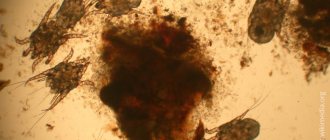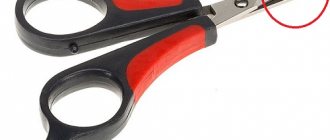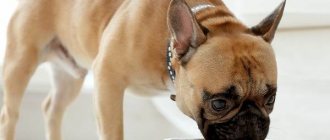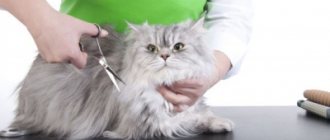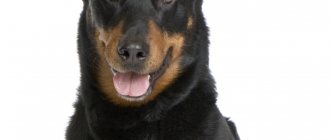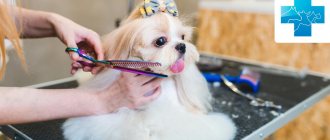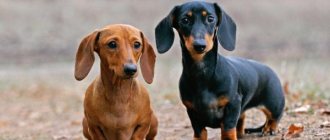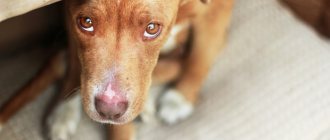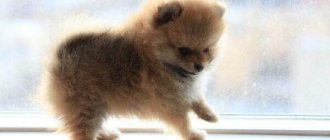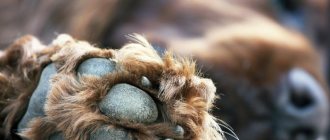Trimming dog nails is a hygienic procedure that is recommended for many breeds, especially those that do not regularly go outside. But even in serious and large pets of guard and hunting varieties, if you do not monitor the condition of their paws, problems and even illnesses can arise. Therefore, a caring owner must thoroughly understand why and how to carry out this important procedure.
- 1 Mr. Tail recommends: why should you trim your dog’s nails?
- 2 Structure of the claw
- 3 Haircut or filing
- 4 Frequency of nail trimming
- 5 Necessary tool
- 6 Procedure sequence
- 7 Precautions
- 8 Other useful tips
- 9 Possible claw diseases
- 10 Cost of services at the clinic
Mr. Tail recommends: why should you trim your dog’s nails?
Trimming the claws of domestic cats is familiar and understandable to owners; it helps avoid scratches that children often receive while playing with pets, and protects against damage to wallpaper and furniture.
Trimming dog nails is a fairly new recommended procedure; its meaning and necessity are not clear to every owner. But the effectiveness of this process has now been proven and there are several reasons for its regular implementation. Moreover, this applies to almost all breeds of dogs, but is especially true for indoor decorative ones.
Photo gallery of dog nail trimming:
The main factors requiring regular nail trimming are:
- Too long nails prevent the dog from walking normally. In this case, the fingers cannot connect, the paw pad “spreads”, exposing the delicate skin in the interdigital space, which often leads to injuries and cuts.
- Overgrown claws in pets often grow into the skin, which can lead to infections. This phenomenon usually occurs on the lateral phalanges.
- Dogs that eat a good diet tend to have very strong and hard nails. Even if the dog walks a lot, they do not have time to wear down, but the risk that they will break and injure the paw is great. There is also a concern that if a claw that is too long gets caught on something, the animal may simply pull it out. Therefore, all arguments are also important for pets walking on the street.
- In domestic dwarf breeds that spend little or no time outdoors, their claws also clatter loudly on the floor. With a sedentary lifestyle of these pets, the risk of ingrowth increases. Often such dogs try, just like cats, to sharpen their nail plates on furniture.
Of course, in order not to injure the dog, you must have certain skills to carry out this procedure. Perhaps the first few times it is worth doing it in a clinic with a good specialist and purchasing a high-quality instrument.
What happens if you don't cut your hair?
If you do not pay attention to the fact that the dog is uncomfortable with overgrown claws, the result will not only be dissatisfaction and discomfort, but also:
- Problems with joints and bones. When an animal's claws grow too long, it becomes uncomfortable for it to move and it begins to place its paws clubfoot, sideways. After a few months, a negative effect appears: constantly inverted joints get used to the new position and are easily turned out, the gait changes, and pain in the spine appears. In breeds that are prone to problems with joints - corgis or chow-chows - the process goes faster.
- Balance problems. The new gait not only causes discomfort and has a negative impact on the joints, but also makes the dog awkward. Running outside for a ball, she may trip, fall and get injured.
- Behavior problems. A dog that constantly suffers from discomfort becomes irritable and capricious, begins to snap and become nervous. She also begins to grind her claws down on her own: she digs floors, scratches furniture, scratches at walls, and weaning her off of this is more difficult than cutting her claws.
Overgrown claws can easily get caught on grass, carpet or gravel, and this can result not only in damage to the claw, but also in injury to soft tissues. To cure something like this, you need a veterinarian, injections and bandages, otherwise the wound will fester and lead to blood poisoning.
Trimming your nails on time is more pleasant and easier than dealing with the consequences of not trimming.
Structure of the claw
In addition, you should have a basic understanding of the anatomy of a dog's nails.
Based on the shape of the claw, there are three types:
- Concave. Resembles a flat arc, blunt and very hard.
- Feline. Also bent, but with a steeper arc and a sharper end.
- Straight. It is also called hare. The claw is long and usually sharp.
The first and second types are typical for working and hunting breeds, and hare's claws are more common in small decorative dogs.
With all this, no matter what shape a dog’s claws have, their structure is always the same and includes:
- The keratin shell is the outer visible layer. It is he who is constantly growing and needs to remove part of it in a timely manner.
- The claw bed is the inner part. It is penetrated by numerous small blood vessels and nerve endings. When trimming, it is important not to touch them. Moreover, the first procedures are the most dangerous. If haircuts are carried out regularly, the trunk of the vessel is shortened and the risk of injury is reduced.
A dog's claws are a logical continuation of the paw, and it would be wrong to draw an analogy with the structure and cutting of human nails.
A dog uses its claws to perform many actions - maintaining balance when walking and running, digging, protecting itself from potential enemies. Therefore, this part of the pet’s body requires careful treatment and care.
In order for the dog to be comfortable, the claw must be removed from the surface from two to eight millimeters.
In dogs with light coats, the nails are usually white and transparent and all blood vessels are visible. In dark breeds it is difficult to notice them and pruning must be carried out especially carefully and carefully.
Different breeds
Using the above tips and recommendations, you can trim the nails of almost any dog, regardless of its breed and size. However, there are breeds in which the process of trimming nails has some peculiarities. All these dogs have one thing in common: they are classified as indoor and decorative dogs and are very small in size. These include the Yorkie, Chihuahua, Miniature Spitz and Toy Terrier.
How to cut hair for small breed dogs?
York
Let's figure out how to properly cut a Yorkie's (Yorkshire terrier) nails. After all, their claws need to be trimmed regularly not only for the sake of beauty, but also to avoid health problems. If the claws grow too long, they can curl up and grow into the pads of the toe.
- Yorkies need a comprehensive paw treatment, which also includes trimming the hair between the toes. This should be done 1-2 times a month.
- It is better to trim your Yorkie's claws after bathing, when they are steamed.
- You can put the dog on your lap, or put it on a table or on the floor - so that it is comfortable for you.
- It is recommended to trim your Yorkie's nails using a guillotine. After trimming, you need to clean the cut with a file.
Visual video:
Chihuahua
A note for those who are interested in how to properly cut a Chihuahua's nails:
- Puppies of this breed need to trim their nails once every two weeks, but for adult Chihuahuas it is enough to do this procedure once a month.
- For these dogs, guillotine nail clippers are best suited. Some owners file their Chihuahuas' claws with a file or grind them down with an electric scratching post, but this is a rather long and unpleasant procedure for dogs.
- Before trimming nails, you need to trim the hairs between the toes. This can be done conveniently with small scissors with rounded edges.
- Take the paw and, pressing lightly on the pad of your finger, insert the claw into the “guillotine”. The claw must be cut at an angle of 45°.
- First you need to cut off no more than 1 mm of the claw, and then carefully examine the cut. If the horny surface is still visible, you can trim another 1 mm, but only until the dark dot becomes visible.
IMPORTANT ! You should not forcefully cut your Chihuahua's claws. If the dog gets scared or feels rough treatment, then next time it will be much more difficult to persuade it to undergo this procedure.
Spitz
Like all other dogs, Pomeranians need to have their nails trimmed from time to time. It is better to do this with guillotine-type nail clippers for small dogs.
Before trimming, trim the hair on your dog's toes if necessary.
To carefully trim the claw and avoid touching the pulp, take the Spitz's paw, press on the pad and hold the claw up to the light. This will help determine where the keratinized part ends. If you still can’t see the pulp, then just start cutting about 1 mm at a time until you see a point on the cut. After this, clean the cut with a file.
Toy terrier
Toy puppies begin to trim their claws already at one and a half weeks of age and do this every 15-20 days. Adult dogs of this breed have their nails trimmed every 20-30 days.
It is necessary to trim the toy terrier's nails, if only because due to the small weight of these dogs, their claws do not wear down even while walking on asphalt or gravel, no matter how long the toy walks.
Place the dog on your knees and, taking its paw, pressing on the pad, extend the claw, then cut it off by 3-4 mm. It would be enough.
ATTENTION ! Toy terriers, despite their small stature, are distinguished by rare stubbornness. If you give up ahead of time and let him go until the end of the procedure, then he will not allow you to trim his claws; on the contrary, he will resist even more.
Dachshund
This is the most important procedure in caring for a dachshund! When you hear that your dog begins to knock his claws on the floor while walking, it’s time for a haircut. .
Haircut or filing
In principle, it does not matter whether the dog’s nails are trimmed or filed. Trimming is faster, but is more likely to cause pain to the dog.
An electric file is a tool with replaceable attachments that rotate and grind down the claw. This procedure takes longer, but the possibility of pulp injury is reduced.
In addition, when filing, the formation of sharp edges and burrs is impossible. But you have to choose one or another method of shortening the claws based on the pet’s preferences. Some people are scared by the sound of an electric machine, and they categorically refuse to file.
During this operation, care should be taken not to touch the paw pads, this will cause severe pain in the dog and will forever instill in him a fear of the procedure.
It should be remembered that the claws shortened with a nail cutter will also have to be filed in order to smooth out the sharp edges and prevent the plate from delaminating.
Be careful!
Take special care in the following situations, which may lead to complications:
- If the animal was previously injured when you tried to trim its claws and now has an extremely negative attitude towards the procedure, then it is better to immediately contact a professional groomer or veterinarian;
If your dog has been injured once during nail trimming, subsequent sessions will be difficult for him.
- Do not refuse sedatives if the groomer offers them. There are often situations when even in clinics an animal experiences pain when cutting its claws;
- If the claw bleeds even 30 minutes after the end of the procedure, you should immediately contact a veterinarian for help.
Frequency of nail trimming
It is impossible to establish any universal frequency for cutting or filing a dog’s nails, since it depends on the pet’s lifestyle. In dogs that walk frequently, especially in urban environments, they usually wear down quite a bit on their own. Decorative breeds that spend most of their time in the house grow faster.
The claw should not be allowed to grow excessively, as this lengthens the blood vessels passing through the pulp, and the risk of injury increases.
Typically the following cutting schedule is followed:
- puppies - once every month and a half;
- adult dogs - monthly.
If you hear a clicking sound in the house when you walk, then you should not postpone the procedure.
An attentive owner notices that a pet whose nails are not trimmed at all or irregularly tries to gnaw them out on his own. In this case, wounds often appear that are easily infected, itching and irritation occur. You also need to remember that dogs have toes that do not come into contact with surfaces when walking. The claws on them do not wear down on their own, even if the dog walks often and for a long time.
It is better to start accustoming your pet to shortening its nail plates at an early age. The puppy’s claws are thin and soft, the procedure is quick and painless, regularity will teach the baby to calmly tolerate the haircut.
You can start it from three weeks of life, especially since in this case the risk of injury to the skin of the nursing bitch when puppies suckle will be reduced. In this case, overgrown claws will not lead to dislocations of fragile paws and to their incorrect positioning.
Cosmetics
Dog owners often complain about constant clicking noises in the house. Annoying sounds encourage owners to contact specialists to solve this problem. And then special caps for claws come to the rescue. They are made of silicone, safe for the wearer. The caps act as “anti-scratches”, so thanks to them you don’t have to worry about furniture and other vulnerable things.
Special caps for claws
“Anti-scratch pads” are used if there is a visit to the veterinarian or playing with small children. The caps are fixed with a special glue and then fall off on their own. It should be remembered that not all dogs will appreciate this innovation.
Necessary tool
If the dog owner decides to shorten the pet’s claws on his own, then, first of all, he should take care of purchasing the necessary tools and improvised means:
- Claw cutter. It can be pruning or guillotine type. The first is similar to ordinary scissors with rubberized handles and one of two sharpened curved blades. The guillotine has only one cutting edge, and the tool itself is a kind of lever that cuts off the nail plate. Sizes vary for different breeds. The main requirements for a nail clipper, regardless of its type, are high-quality blade material (stainless brass or steel), good sharpening, a rubberized handle (comfortable to hold) and strong fastening of parts.
- Files. It is needed for processing the cut edge. It can be simple or electric.
- Nail scissors with rounded ends.
- Antiseptics. Hydrogen peroxide, Iodine, Chlorhexidine, Miramistin, Potassium permanganate should be on hand for emergency treatment of accidental cuts.
- Materials to stop bleeding. This can be sterile cotton wool or bandage, alum, talc.
- Sea salt, chamomile or calendula for baths.
It must be remembered that ordinary scissors cannot be used to shorten a dog’s nails, as they will lead to delamination of the nail plate.
How?
Let's discuss cutting tools. When choosing a nail clipper or file, first of all, you need to proceed from the size and breed of your pet. It is very important to choose a tool of a suitable size for it, since a nail clipper that is too large will slip and injure the dog when trimming a nail, and it is simply unrealistic to trim the claws of a large dog while using a nail clipper for small breeds.
How can you trim a dog's nails?
The first and most obvious choice is nail clippers. They come in two types:
- Scissors - similar in appearance to garden pruning shears, consist of two blades and two handles. The first type of nail clippers is used to trim the nails of large dogs, although they can also cut the nails of medium breeds.
- Guillotine shears - they have a hole for a claw and a lever handle. Guillotine shears are used only for trimming the nails of dogs of medium and small breeds.
Classic nail clippers and scissors
Claw-guillotine
Advantages of nail clippers:
- The nail trimming procedure does not take much time
- There are many variations of nail clippers in size, which allows you to choose the most optimal option for a particular dog.
Disadvantages of nail clippers:
- If handled improperly, the risk of injury is quite high.
- If you choose the wrong tool, you can break or splinter your dog's claw.
Some owners of small dogs are afraid to cut their pets' nails and prefer to file them. There are many files designed for claws of different thicknesses and strengths.
Pros of files:
- With proper handling of the tool and a sufficient level of care, there is low trauma.
- You can choose a file with a notch of any size and any strength that would be most suitable for a particular dog.
An ordinary file for human manicure will not work, because the durable claws of pets will only succumb to the coarse abrasive of a specialized tool.
But if there is no way out, then choose files for false nails, they are wear-resistant and file everything well! Disadvantages of files:
- They can only shorten their claws on small dogs, which are also accustomed to prolonged manipulation.
- Shortening a nail by filing it can be stressful for a dog who is not used to it.
- If you handle the file carelessly, you can injure your pet.
Along with the listed tools, there are electric scratching posts. With their help, you can file down claws to the desired shape and size.
Pros of electric scratching posts:
- They file down the claw much faster than with a mechanical file.
- When handled carefully, they are almost safe for the dog and the owner.
Disadvantages of electric scratching posts:
- The high price of these tools and consumables themselves.
- Noise during operation can greatly disturb the animal.
- When the tool is used, the claw heats up. This can be unpleasant for the dog, and if it gets too hot, it can even cause him pain.
So, the most suitable tool for trimming dog claws can still be considered a regular nail clipper , especially since it is easy to choose for an animal of any size and breed.
Sequence of procedure
To shorten your pet’s claws quickly and painlessly, the dog owner should prepare for the procedure in advance and study the sequence and technology of performing all actions:
- First of all, accustom your dog to the sight and sounds of nail clippers or nippers from a young age. You can playfully click the tool in front of the puppy so that the animal will not be afraid of it in the future. To encourage your pet, you need to treat it with treats.
- Before the first procedure, you need to think about a comfortable non-slip surface. This could be a table, a couch or a wide bench.
- You should invite an assistant to help restrain your pet or distract him by offering him a treat. This should be a person familiar to the dog and not causing him concern.
- It is better to trim nails when the pet is in a relaxed state, for example, he came after a tiring walk, played for a long time, or ate a hearty meal.
- While the animal is focused on a toy or food, you need to take its paw and carefully feel the pads of the fingers, each claw, determining the location of the nail bed.
- The owner should stand in front of the pet so that his hands are along his paws. The thumb should fix the pad of the toe on the front paws from which the claw is cut, the rest should grip the foot.
- It is more convenient to work with the hind legs when the dog lies on its side. Large pets are held down by leaning on them with the whole body and not allowing them to get up.
- It is better not to touch the spaces between your fingers. This can cause the dog discomfort or tickling and involuntary withdrawal of his paws.
- Then cut off the tip of each claw, leaving at least 2 mm to the pulp. In this case, you need to lightly press on the pads of your fingers so that they straighten. The cut is made only from below, in no case from above or from the side, this will cause delamination of the plate. Its angle is about 45 degrees or straight. You should be especially careful when working with dark breed dogs; it is better to cut off small sections, removing layer by layer.
- In general, it is advisable to trim the tip gradually, giving it the desired shape. If the cut surface is oval, the nail bed is nearby.
- Rudimentary claws have to be cut off more often, since they do not wear off at all and do not come into contact with surfaces when the pet moves.
- Now each cut must be carefully filed and sanded.
- If fur grows between your pet's toes, it is best to carefully cut it off with nail scissors with rounded tips.
- Briefly soak your pet's paw with trimmed claws in a bath of saline solution or chamomile infusion to relieve irritation and redness.
During the entire process, you should not raise your voice at the dog or show irritation and anger; the owner’s mood should be calm, friendly and positive. You should speak to your pet kindly, but firmly, calming him if necessary and forcing him to obey.
You can periodically sit next to the dog, stroking his paws and simply touching his claws with a nail clipper, convincing him that there is nothing to be afraid of.
If the procedure does damage the pulp, then under no circumstances should the dog be allowed to escape. After putting the tool aside and interrupting the cutting process, you should gently clasp your pet with your hands, calming it down. Then treat the bleeding site with prepared products.
If the pet exhibits aggressive behavior and attempts to bite, claw shortening is stopped; it is better to have this procedure performed in a clinic by a professional.
Before the procedure, you should carefully examine all your pet’s claws; in some dogs, they are completely worn off when walking.
Some animals are not able to endure the entire procedure. Then you can divide it over time, cutting off one more claw each time, accustoming the dog to shortening the nail plates gradually.
How is the service provided in the salon and how much does it cost on average?
The standard cost of a hygiene procedure is in the range of 300-1500 rubles. The final price depends on the pet’s behavior and the need to use sedatives.
Trimming in the salon
When contacting the salon, the groomer establishes contact with the pet and tries to carry out the event without the use of sedatives. The process takes a little time - from 20 to 30 minutes. In case of severe aggression, the dog is given a drug, and after its effect begins, the overgrown plates are shortened.
Important! For help, you need to contact professional salons, not dubious offices.
Precautionary measures
If injury occurs when shortening the claws, the following steps should be taken:
- Stop the bleeding by sprinkling talcum powder on the wound and pressing it against the affected surface until the bleeding stops completely, even if it takes several minutes. If there is no special product, starch, flour, or a bar of soap will do.
- After this, do not let your pet step on its paw for at least 15-20 minutes. You can keep him in place by offering treats and talking gently, comforting and caressing him. The main thing is to maintain the trust of your friend.
- If the bleeding does not stop within half an hour, you should contact a veterinary clinic.
My dog broke a nail at the root, what should I do? How to stop a dog's nail from bleeding?
If a dog breaks a claw under unfavorable conditions and begins to limp, immediately check the integrity of the claws.
Follow the procedure step by step:
- Gently hold your pet's paw. Examine it and hold the dog close to you so that it feels your support.
- If bleeding occurs, wrap the paw with a bandage or towel to provide pressure.
- If the bleeding does not stop for more than ten minutes, then use a special pencil.
- Next, remove the broken claw using scissors. Cutting is painful, but will result in rapid growth of a new nail.
- The root should be treated with an antibiotic to avoid infection and minimize bleeding.
Pikinese
Other useful tips
If you trim your dog's nails every two weeks, his keratin layer will increase and the nail bed will recede.
It is much easier to train a puppy to trim their nails than an adult dog. Do not trim the claw blindly. If you couldn’t inspect it, you shouldn’t touch it; you might need to cut its fur first.
If your pet is nervous and easily excitable, you can give him sedative herbal remedies before shortening the nail plates.
When carrying out manipulations with sedatives in veterinary clinics, you can ask the doctor to trim the claws at the same time. Most often, clinic staff in this case agree to do this work without payment.
Do not use alcohol-containing products to stop bleeding in case of injury. This will only increase the pain and cause your pet to panic.
The most unpleasant thing is when a claw is pulled out if the nail cutter is compressed slowly, and the dog pulls out its paw at that moment. In this case, the pet is very painful and scared, as blood vessels and soft tissues are torn. You should immediately contact the clinic after applying ice wrapped in cotton cloth to the wound.
For large breed dogs, it is better to use a pruning shear rather than a guillotine nail clipper.
Possible claw diseases
If your dog's nails are not properly cared for, the following can happen to them:
- Ingrowns. In this case, the claw is strongly bent and recessed (grown) into the soft tissue of the finger pad. When walking, the pet experiences pain, and infection occurs inside due to constant irritation of the wound.
- Panaritiums. This is nothing more than inflammation of the nail bed, pulp due to wounds of the fingers, claws, and surrounding tissues. The foot becomes hot to the touch, swells, suppuration, fever, and refusal to eat may appear.
- Breaking off and pulling out claws. This happens when formations that are too long get caught on something. Such wounds bleed heavily and often become infected. The pet is experiencing pain.
In all these cases, it is necessary to apply an antiseptic bandage, for example, with Chlorhexidine. You can later use syntomycin liniment, Vishnevsky ointment, Ichthyol ointment. If the pet does not heal for a long time or the general condition of the pet worsens, you should contact a veterinary clinic.
Black
Inexperienced owners do not always understand how to cut a black claw, because when cutting them (and dark brown claws) a problem arises: the pulp cannot be seen and there is a risk of cutting off more than necessary.
You need to act calmly and without haste, cutting the claw to the desired size in several steps, removing 0.5-1 mm each time. After each cut, you must carefully inspect the cut site. If you notice a bright dot on it, then that’s it, it’s time to stop, otherwise you may touch the pulp .
